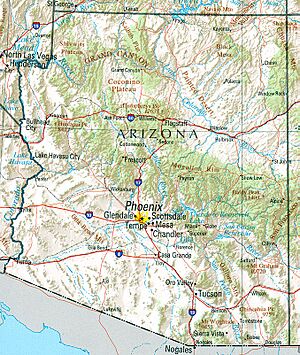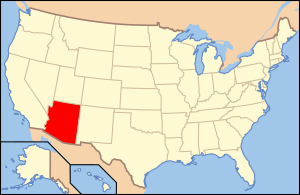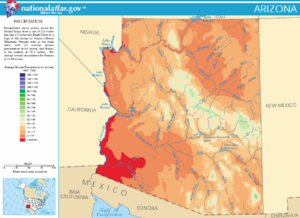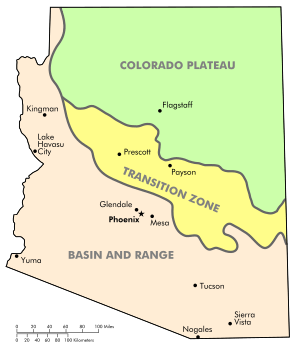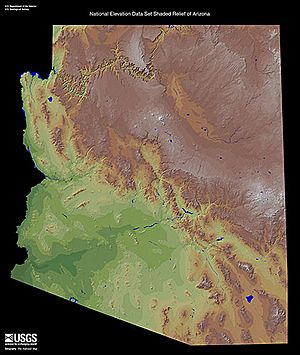Geography of Arizona facts for kids
Arizona is a state in the southwestern part of the United States. It's known for its amazing and varied landscapes. You can find deep canyons, hot deserts, cool mountains, and unique rock formations here. Arizona shares borders with Utah, New Mexico, Nevada, and the Mexican state of Sonora. It also has water borders with California and Baja California (Mexico) along the Colorado River. Arizona is one of the "Four Corners" states, meaning it meets Colorado at a single point.
Arizona is a very large state, covering about 113,998 square miles (295,240 km2). This makes it the sixth largest state in the U.S. Only a tiny part of Arizona (0.3%) is water, which is one of the lowest amounts for any state. Arizona stretches about 335 miles (539 km) wide and 390 miles (628 km) long. Its average height above sea level is about 4,000 feet (1,219 m). The very center of Arizona is in Yavapai County, about 55 miles (89 km) southeast of Prescott.
Contents
Arizona's Weather and Climate
Arizona is a big state with many different elevations, so its weather can change a lot from place to place. Most of Arizona gets very little rain. It's usually described as having a dry (arid) or partly dry (semi-arid) climate. The northern parts and mountains are generally cooler. The southwestern areas stay warm almost all year.
Rainfall in Arizona
Rainfall in Arizona depends on how high up a place is and the time of year. Most rain falls in early winter when storms from the Pacific Ocean cross the state. More rain also comes in summer from winds blowing in from the Gulf of Mexico. Summer rains often come as thunderstorms. These storms can bring strong winds, dust, and sometimes hail. The most rain falls in the mountains of central and southeastern Arizona. The driest parts are in the southwest.
Some places like Flagstaff get rain about 70 days a year. Other places like Yuma only get rain about 15 days a year. The highest mountains can get up to 30 inches (762 mm) of rain each year. The driest southwestern region gets less than 3 inches (76 mm) of rain annually. Arizona has low humidity and lots of sunshine, so water evaporates quickly. During El Niño years, Arizona winters are usually wetter. During La Niña years, winters are drier.
Snow in Arizona
Even though Arizona is known for its warm deserts, snow is common in many parts of the state. From November to March, Pacific storms bring heavy snow to the mountains in central, northern, and southeastern Arizona. Even southern towns like Nogales, near the Mexican border, can get moderate snow. This happens because temperatures drop below freezing at night in winter.
The edges of the Grand Canyon also get snow in winter because they are very high up. The South Rim, about 7,000 feet (2,134 m) high, gets about 60 inches (1.5 m) of snow each year. The North Rim, over 8,000 feet (2,438 m) high, gets even more snow, about 144 inches (3.7 m) annually.
Arizona's Temperatures
Because Arizona is dry and doesn't have many clouds, temperatures can change a lot. This happens from day to night, and from season to season. Parts of the Sonoran Desert stay warm all year during the day. Other areas get cold regularly in certain seasons. For example, Yuma's average daily temperatures range from 43 to 67°F (6 to 19°C) in January. In July, they range from 81 to 107°F (27 to 42°C).
In Flagstaff, which is in the middle of the state, January temperatures average from 14 to 41°F (-10 to 5°C). In July, they range from 50 to 81°F (10 to 27°C). The hottest temperature ever recorded in Arizona was 128°F (53°C) in Lake Havasu City. The coldest was -40°F (-40°C) at Hawley Lake.
Arizona's Amazing Landscapes
Arizona has two main types of land areas, called physiographic regions. These are the Colorado Plateau and the Basin and Range Province. There's also a special area in between them called the Transition Zone.
The Colorado Plateau
The Colorado Plateau is a mostly flat, partly dry area. It sits high up, between 5,000 and 8,000 feet (1,524 to 2,438 m) above sea level. This huge area covers about 140,000 square miles (362,600 km2). It includes most of northern Arizona. The plateau ends at a steep rock wall called the Mogollon Rim.
The Colorado Plateau is often called "Red Rock Country." This is because its brightly colored rocks are visible due to the dry weather and erosion. The famous Grand Canyon is part of this plateau. It shows off some of the most unique rock layers in the world. Other amazing natural spots here include Antelope Canyon, Meteor Crater, the Painted Desert, and the Petrified Forest.
The Transition Zone
The Transition Zone is a mountainous area in central Arizona. It's where the high Colorado Plateau meets the lower Basin and Range Province. This area has features from both regions. It's made up of many rugged mountain ranges and valleys. A big part of this zone is the Mogollon Rim. This is a dramatic cliff that stretches for about 115 miles (185 km).
Mountain ranges in the Transition Zone include the Mazatzal, Santa Maria, Sierra Ancha, and White Mountains. Because the elevation changes so much, the weather can be very different over short distances. This zone often gets more rain than other parts of Arizona because of its mountains. Temperatures also change a lot with altitude.
The Basin and Range Province
The Basin and Range Province covers the southern and western parts of Arizona. This region is known for its tall, narrow mountain ranges that stand out from long, flat deserts. These mountains can rise over 9,000 feet (2,743 m) high. They create "islands" of cooler climates where different plants and animals live.
The geology here is due to the Earth's crust stretching and thinning. This area has some of the thinnest crust in the world. The Basin and Range Province is very important for mining. It provides almost all the copper mined in Arizona. It also has other valuable minerals like gold, silver, and barite.
Arizona's Rivers
The main rivers in Arizona are the Colorado River and its major branch, the Gila River. Almost all of Arizona's water drains into either the Colorado River or one of its branches.
The Colorado River
The Colorado River is super important to Arizona because the region is so dry. This river is famous for creating the Grand Canyon over millions of years. Many irrigation systems take water from the Colorado River. The most important one for Arizona is the Central Arizona Project. This project is 336 miles (541 km) long. It moves 1.5 million acre-feet (1.85 km3) of water from Lake Havasu City to central and southern Arizona.
The river is also used to make electricity with several dams. These dams include Glen Canyon Dam, Hoover Dam, Davis Dam, Parker Dam, Imperial Dam, Laguna Dam, and Morelos Dam.
The Gila River
The Gila River is about 650 miles (1,046 km) long. It flows from southwestern New Mexico to meet the Colorado River near Yuma. The upper part of the Gila River flows freely. However, the part of the river below Phoenix is often just a trickle or completely dry. This is because its water is used for farming. The only big dam on the Gila River is Coolidge Dam.
Arizona's Deserts
Arizona is home to several unique deserts, each with its own special features.
The Sonoran Desert
The Sonoran Desert covers the southwestern part of Arizona. This includes cities like Phoenix, Tucson, and Yuma. It's one of the hottest deserts in the United States, staying warm all year. Even with little rain, it has many different plants and animals. This is because it gets two rainy seasons each year. Many plants, especially different types of cactus, grow here because they have special ways to live in the dry climate. The Sonoran Desert is the only place in the world where the saguaro cactus grows naturally. Other cacti like the fishhook, prickly pear, and organ pipe also thrive here.
The Mojave Desert
A part of the Mojave Desert is in northwestern Arizona. This desert is higher up than the Sonoran Desert. You can tell where the Mojave Desert is by finding the Yucca palm trees, which only grow there. Unlike the Sonoran Desert, the Mojave Desert has fewer trees and less variety.
The Painted Desert
The Painted Desert is a large area of badlands in northern Arizona, on the Colorado Plateau. It covers at least 146 square miles (378 km2). It stretches from near the Grand Canyon to beyond the Petrified Forest. The desert gets its name from the many colorful layers of rock and clay. These layers were left exposed by erosion. In the southern part, you can find fossilized remains of an ancient forest from millions of years ago. Most of the Painted Desert is on Navajo Nation land, and you can only explore it on foot.
The Chihuahuan Desert
A small part of southeastern Arizona is in the Chihuahuan Desert. This desert is at a higher elevation compared to the Sonoran Desert. Because of this, it usually has milder temperatures during the summer.
Islands in Arizona?
Arizona is the third largest state that doesn't have an ocean coastline. Montana and New Mexico are larger and also landlocked. Even though Arizona is landlocked, it does have islands! The state has a very small amount of water, only about 363.73 square miles (942 km2). Most of Arizona's islands are in the Colorado River, especially in Lake Mead. Lake Roosevelt also has several islands.
Arizona's Mountains
Arizona is a very mountainous state with rugged terrain. It's home to the world's largest continuous forest of ponderosa pine trees. Many mountain ranges are over 9,000 feet (2,743 m) high. Some even keep snow all summer long.
Arizona has 194 named mountain ranges. The highest ones are along the edge of the Colorado Plateau. These include the volcanic San Francisco Peaks near Flagstaff and the White Mountains. The Basin and Range region in southern and western Arizona has many rugged ranges. These often stand like "sky islands" in the Sonoran and Chihuahuan deserts.
Arizona's Ten Highest Mountain Peaks
Humphreys Peak
Humphreys Peak is the highest point in Arizona. It's part of the San Francisco Peaks, a volcanic mountain range about 9 miles (14 km) north of Flagstaff. It reaches 12,633 feet (3,851 m) above sea level. This mountain is so high that it can have snow even in summer. The Humphreys Trail is the only path to the top. Near the summit, Humphreys Peak has the only subarctic tundra area south of the Rocky Mountains.
Agassiz Peak
Agassiz Peak is Humphreys Peak's "sister" mountain. It's one of the San Francisco Mountains' "Big 4" highest peaks. Its summit is 12,356 feet (3,766 m) above sea level. This mountain is closed to climbers in summer to protect its delicate tundra environment. It usually loses its snow by late May, but sometimes keeps it until June.
Fremont Peak
Fremont Peak is also in the San Francisco Mountains, at 11,946 feet (3,641 m) above sea level. This summit is not very well known. It's located along the Doyle Saddle and isn't very noticeable. It's more of a high point on a ridge than a distinct peak. The Humphreys Trail runs along this ridge and over Fremont Peak.
Aubineau Peak
Aubineau Peak is the fourth highest summit in Arizona, reaching 11,818 feet (3,602 m) above sea level. This is a very steep peak. It's on the north side of the San Francisco Mountains, next to Abineau Canyon.
Ree's Peak
Ree's Peak is smaller than most of the San Francisco mountains, at 11,444 feet (3,488 m). It forms the northeastern tip of the range. This peak doesn't have tundra but is home to the famous bristlecone pine trees. It's hard to spot unless you look directly at it, as other peaks often hide it.
Doyle Peak
Doyle Peak is 11,440 feet (3,487 m) high. If you look at the San Francisco Mountains from Flagstaff, it's the peak furthest to the right. You can see it best from Shultz Pass road. It's known for its continuous belt of aspen trees. This peak is the start of the Doyle Saddle, which connects it to Agassiz Peak.
Mount Baldy
Mount Baldy is in Arizona's White Mountains, on the Fort Apache Indian Reservation. It's an eroded mountain peak, with its summit at 11,391 feet (3,472 m) above sea level. Locals named it "Baldy" because its upper ridge has no trees. Mount Baldy is home to the Sunrise Ski Area. It's a single, prominent peak with gentle slopes. Mount Baldy has a bristlecone pine forest. Some people think the White Mountains are an extension of the Rocky Mountains because they have similar elevations, trees, animals, and weather.
Mount Ord
Mount Ord is 11,348 feet (3,459 m) high and is part of the White Mountains. It's located in Apache County on the Fort Apache Indian Reservation. Snow often stays on this mountain the longest in summer. This is because of its high elevation and gentle north slope. Snow can stick for 3 to 6 inches (7.6 to 15 cm), sometimes more, until June.
Paradise Butte
Paradise Butte is 11,148 feet (3,398 m) high. It's found in the White Mountains near Mount Baldy and Mount Ord, close to Sunrise Ski Park.
Mount Thomas
In Apache County, Mount Thomas reaches 11,121 feet (3,389 m) high.
|


